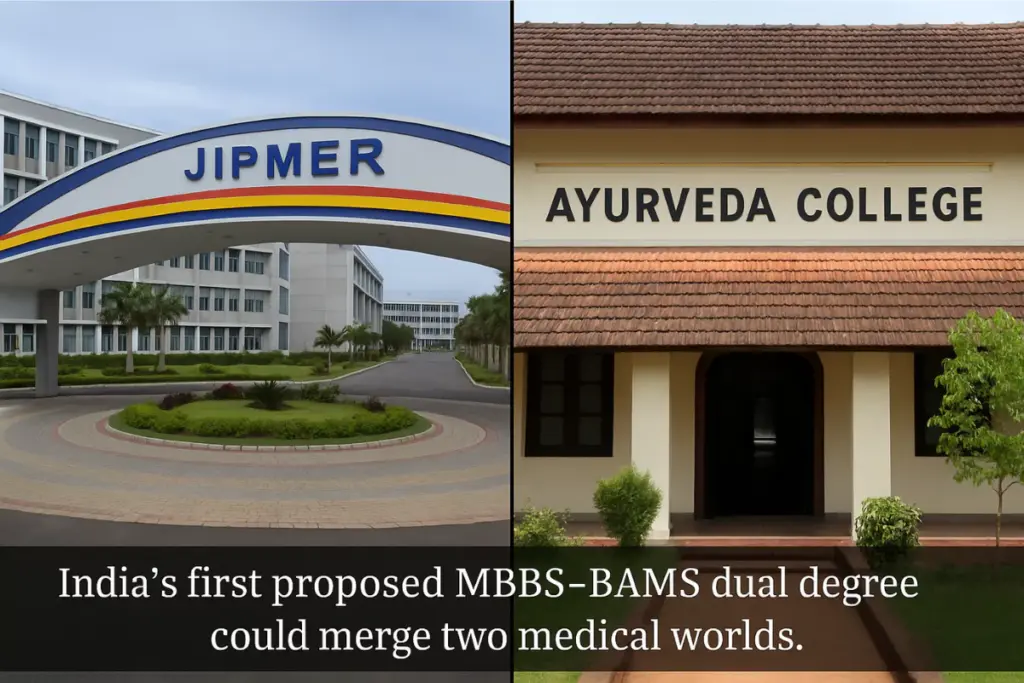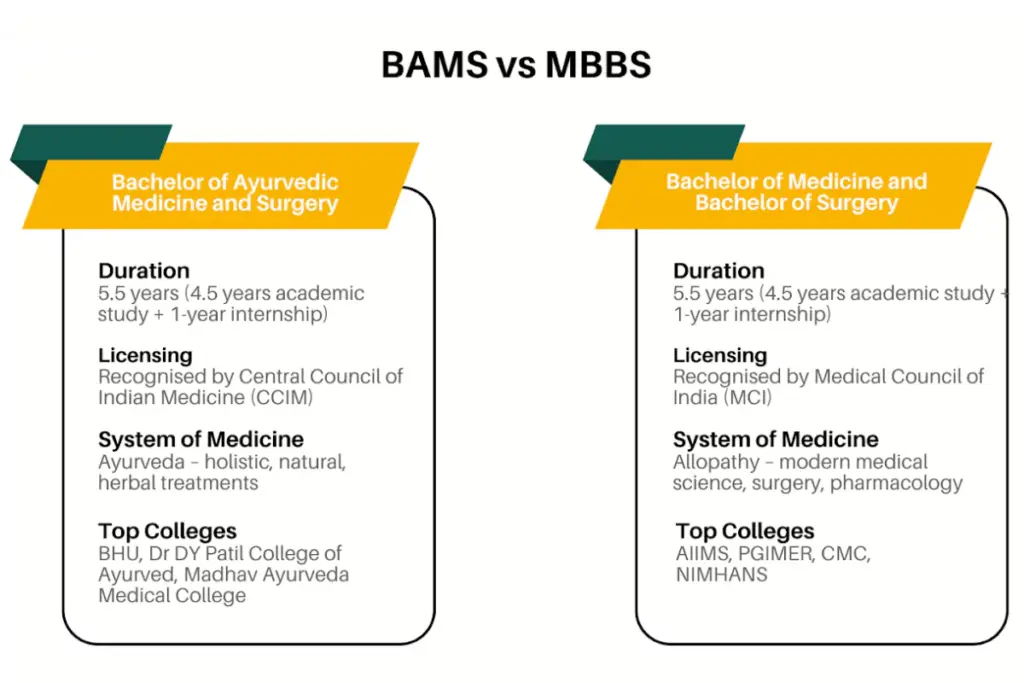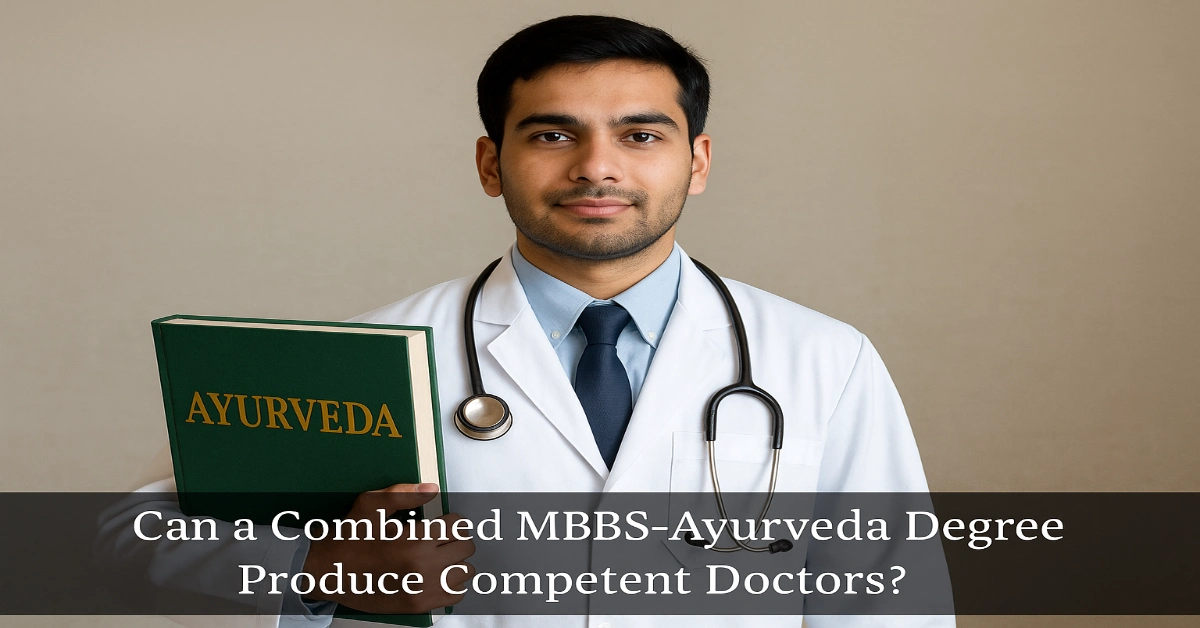Combined MBBS-BAMS Degree: India’s Health Ministry has proposed an idea for an integrated MBBS–BAMS degree at JIPMER, Puducherry. If implemented, students would earn both MBBS and BAMS degrees in 5 years plus a 1-year internship, combining allopathic and Ayurvedic learning.
Supporters call it “a rare opportunity to create truly holistic doctors,” while critics warn of legal and safety issues.
Combined MBBS-BAMS Degree: Overview
- Program name: Integrated MBBS–BAMS Dual Degree
- Location: JIPMER, Puducherry
- Duration: 5 years coursework + 1-year internship
- Outcome: MBBS + BAMS (dual degrees)
- Status: Proposal stage – no final approval from NMC or NCISM yet

How the Combined MBBS–BAMS Program Works
Course Structure – Key Highlights
| Component | Allopathy (MBBS) | Ayurveda (BAMS) |
|---|---|---|
| Basic Sciences | Anatomy, Physiology, Biochemistry | Ayurvedic Sharir, Dosha-Dhatu Concepts |
| Clinical Training | Internal Medicine, Surgery, Paediatrics | Panchakarma, Rasashastra, Herbal Therapeutics |
| Research & Evidence | Biostatistics, Clinical Trials | Ayurvedic Clinical Research |
Career Path for Graduates
- Practice modern medicine and Ayurveda (subject to licensing)
- Sit for postgraduate entrance exams in either stream
- Potential roles in integrative clinics, research institutions, and government health projects
MBBS vs BAMS: Understanding the Two Degrees
Before discussing an integrated MBBS–Ayurveda program, it’s important to understand how MBBS vs BAMS differ in scope, curriculum and professional pathways.
| Aspect | MBBS (Bachelor of Medicine & Bachelor of Surgery) | BAMS (Bachelor of Ayurvedic Medicine & Surgery) |
|---|---|---|
| Regulatory Body | National Medical Commission (NMC) | National Commission for Indian System of Medicine (NCISM) |
| Duration | 5.5 years (4.5 years study + 1 year internship) | 5.5 years (4.5 years study + 1 year internship) |
| Focus | Modern (allopathic) medicine – anatomy, physiology, pathology, pharmacology, surgery, internal medicine, community medicine, etc. | Ayurvedic medicine – classical texts (Charaka, Sushruta), Ayurvedic pharmacology, panchakarma, herbal and lifestyle therapy, with exposure to modern anatomy and diagnostics |
| Licensing | Registration with the State/NMC Medical Council to practice modern medicine | Registration with the State/NCISM Board to practice Ayurveda |
| Career Pathways | MD/MS, DNB, super-specialty courses, hospital practice, research, teaching | MD/MS in Ayurveda specialties, hospital/clinic practice in Ayurvedic care, research, and teaching |
| Scope of Practice | Prescribe allopathic drugs, perform modern surgeries, and provide diagnostic and emergency care | Prescribe Ayurvedic formulations, perform Panchakarma, lifestyle counselling; limited exposure to modern medicine, depending on state rules |
| Legal Restrictions | Cannot prescribe Ayurvedic or herbal drugs without an appropriate additional qualification | Cannot prescribe allopathic drugs unless specifically trained and licensed (varies by state) |
Key Takeaways on MBBS vs BAMS
- Bachelor of Medicine and Bachelor of Surgery (MBBS) represents India’s mainstream, evidence-based modern medical curriculum, producing doctors who work largely in hospitals, emergency care, and surgical settings.
- Bachelor of Ayurvedic, Medicine and Surgery (BAMS) represents India’s traditional healing system, emphasising holistic wellness, prevention, and natural remedies.
- Both are 5½-year programs with internships but have separate councils, laws and licensing systems, meaning they currently produce two distinct professional streams.
- While there is some cross-learning, BAMS includes modern anatomy, and MBBS students learn about lifestyle and community health; each is designed for depth in its own system.
- The Combined MBBS-BAMS Degree proposal attempts to bridge this divide by offering dual expertise in one course, but doing so would require substantial curriculum expansion and legal reform.

Potential Advantages of an Integrated MBBS-Ayurveda Degree
Wider Clinical Perspective
Students get exposure to both body-based and holistic health models, enabling personalised care combining surgery, antibiotics, herbal support, and lifestyle guidance.
Expanded Treatment Options
Doctors could offer evidence-backed therapies from both systems, potentially filling gaps in rural healthcare where patients already use multiple systems.
Emphasis on Prevention and Wellness
Ayurveda’s focus on preventive medicine and lifestyle complements allopathy’s acute care model.
Evidence-Based Integration
If backed by research, India could create a “gold standard” of integrative healthcare, uniting validated traditional wisdom with modern clinical protocols.
Regulatory and Legal Challenges Facing the Combined MBBS-Ayurveda Degree
Absence of Legal Framework
- MBBS and BAMS are governed by separate acts and councils
- No existing provision for a dual degree in the current statutes
Regulator Buy-in Needed
- NMC and NCISM were not formally consulted (per RTI disclosures)
- Without explicit approval, the degree may lack recognition
Licensing and Accreditation Ambiguity
- Unclear how graduates would register and prescribe in both systems
- Risk of employers not recognising the dual qualification
| Challenge | Current Status | What’s Needed |
|---|---|---|
| Legal Provision | None | Legislative amendment |
| Regulator Approval | Not secured | Joint NMC-NCISM curriculum |
| Licensing Pathway | Unclear | New combined registration |
Read Also: History of Medical Education in India: Ancient to Modern Reforms
Safety and Quality Concerns of the MBBS–BAMS Model
Risk of Diluted Expertise
MBBS and BAMS are both 5½-year programs. Compressing them into one course could lead to superficial coverage.
Patient Safety Issues
Without mastery of both fields, cross-prescription could harm patients. IMA calls this “mixopathy” and warns against “hybrid doctors.”
Training Overload
Faculty, labs, and exams may be overstretched to cover two systems in one program.
Expert Perspectives on “Can a Combined MBBS-Ayurveda Degree Produce Competent Doctors?”
Supportive Views
- Dr. B.S. Prasad (NCISM): Evidence-based integration can improve patient outcomes
- Dr. B.B. Aggarwal (Sir Ganga Ram Hospital): Integration should focus on research and patient outcomes, not tradition vs. modernity
Cautionary Views
- Rakesh Mandal (activist): No legal provision for awarding MBBS and BAMS degrees together
- Career counsellor Sanjay Tiwari: Students should not assume automatic recognition of the dual degree
Balanced Solutions for the Integrated MBBS–BAMS Pathway
Gradual Integration Instead of Immediate Dual Degrees
- Cross-training modules for MBBS and BAMS students
- Joint research projects to test safety and efficacy
Evidence-Led Curriculum Design
- Validate Ayurvedic treatments through trials before integration
- Include biostatistics and critical appraisal modules
Clear Career and Licensing Pathways
- Define registration rules for dual-trained graduates
- Create transparent postgraduate eligibility norms
Can a Combined MBBS-BAMS Degree Produce Competent Doctors?
The JIPMER proposal is bold and potentially transformative. It could produce holistic doctors who bridge modern and traditional medicine, but only if legal, regulatory, and training challenges are addressed. Until then, medical students should approach the dual degree with caution and demand clarity regarding curriculum, licensing, and recognition.

